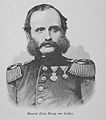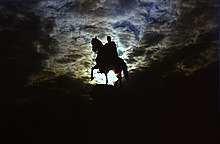Johann (Saxony)
Johann von Sachsen , full name Johann Nepomuk Maria Joseph Anton Xaver Vincenz Aloys Luis de Gonzaga Franz de Paula Stanislaus Bernhard Paul Felix Damasus , (born December 12, 1801 in Dresden , † October 29, 1873 in Pillnitz ) ruled after the death of his brother Friedrich August II. From 1854 as King John the Kingdom of Saxony . He also worked as a translator under the pseudonym Philalethes .
Family and education
Johann was born the sixth of seven children of Prince Maximilian of Saxony and his first wife Caroline of Bourbon-Parma (1770-1804). His father was the youngest son of the Saxon Elector Friedrich Christian, who died in 1763 . His mother Caroline, born Princess of Parma, was a granddaughter of the Empress Maria Theresa . Soon Johann was trained in the administration of the kingdom and took on important tasks, including in the finance college. After the constitution of 1831 was passed, Prince Johann was born a member of Chamber I of the Saxon state parliament and took an active part in its negotiations. During his visit to Leipzig in August 1845, riots broke out because the population demonstrated against him and the military opened fire on the demonstrators ( Leipzig slaughter ).
government
After Johann unexpectedly came to the throne through the accidental death of his older, childless brother in 1854, he took over the constitutional chairmanship of the entire ministry . Thanks to his many years of experience, he oversaw all areas of administration and always formed his own judgment. In fact, he was his own prime minister. At most, the ministers Friedrich Ferdinand von Beust and Johann Paul von Falkenstein gained weight in their own right. The judicial reform of 1855, the expansion of the railway network and the introduction of freedom of trade are mainly due to his suggestions and support. Under him, Saxony transformed into one of the most modern German states. In addition, a trade treaty was concluded with France (1862) and the newly established Kingdom of Italy was recognized. Under the influence of his minister Friedrich Ferdinand von Beust, he campaigned for the Greater German solution to the unification of the empire (including Austria). The Kingdom of Saxony therefore fought on Austria's side in the German War in 1866 . When, after the defeat of Königgrätz, the Prussian Prime Minister Otto von Bismarck persuaded King Wilhelm I to preserve Saxony as an independent state, Saxony finally joined the North German Confederation and in 1871 the German Empire under the hegemony of the Kingdom of Prussia . At the imperial proclamation in Versailles on January 18, 1871, however, he was represented by his son, Prince Georg .
He gave special support to schools and universities. The Saxon Academy of Sciences was promoted by him, the Royal Saxon Association for the study and conservation of patriotic antiquities in 1824 and the magazine New archive of Saxon History founded. 1863
Johann died in 1873 and was buried in the Wettiner crypt of the Catholic Court Church in Dresden.
translator

In addition to his political work, Johann dealt with literature. Under the pseudonym Philalethes ("Friend of Truth", hence his nickname "The Truthful") he translated Dante's Divine Comedy into German as a translation that is still recognized today, substantial parts of it at Weesenstein Castle and Jahnishausen Castle .
family
On November 21, 1822, he married Princess Amalie Auguste of Bavaria in Dresden . The marriage had nine children:
- Maria Augusta (1827-1857)
- Albert (1828–1902), King of Saxony ⚭ 1853 Princess Carola von Wasa
- Elisabeth (1830–1912)
- ⚭ 1850 Prince Ferdinand of Savoy , Duke of Genoa (1822–1855)
- ⚭ 1856 Marchese Niccolo Rapallo (1825–1882)
- Ernst (1831-1847)
- Georg (1832–1904), King of Saxony ⚭ 1859 Infanta Maria Anna of Portugal
- Sidonie (1834–1862)
- Anna (1836–1859) ⚭ 1856 Grand Duke Ferdinand IV of Tuscany
- Margarete (1840–1858) ⚭ 1856 Archduke Karl Ludwig of Austria
- Sophie (1845–1867) ⚭ 1865 Duke Carl Theodor in Bavaria
ancestors
| Pedigree of Johann von Sachsen | ||||||||
|---|---|---|---|---|---|---|---|---|
| Great-great-grandparents |
King |
Emperor |
Elector |
Emperor |
King |
King |
Duke |
Emperor |
| Great grandparents |
King August III. (1696–1763) |
Emperor Charles VII (1697–1745) |
Duke Philip of Parma (1720–1765) |
Emperor Franz I Stephan (1708–1765) |
||||
| Grandparents |
Elector Friedrich Christian of Saxony (1722–1763) |
Duke Ferdinand von Bourbon (1751–1802) |
||||||
| parents |
Maximilian von Sachsen (1759–1838) |
|||||||
| Johann of Saxony | ||||||||
Honors
- The Johannstadt district of Dresden is named after him.
- Monument on the Dresden Theaterplatz by Johannes Schilling
- Monument on the Königstein Fortress in Saxon Switzerland
- König-Johann-Turm , observation tower in the Dippoldiswalder Heide near Dippoldiswalde
- König-Johann-Turm , observation tower on the Valtenberg (Oberlausitz)
- Order Pour le mérite for Science and the Arts in 1869
- Memorial stone next to the Trinity Church in Carlsfeld
literature
- Karlheinz Blaschke : Johann. In: New German Biography (NDB). Volume 10, Duncker & Humblot, Berlin 1974, ISBN 3-428-00191-5 , p. 528 f. ( Digitized version ).
- Johann Paul von Falkenstein : On the characteristics of King Johann of Saxony in his relationship to science and art. Hirzel publishing house, Leipzig 1879 ( digitized version )
- Johann Paul von Falkenstein: Johann King of Saxony. A character image. Wilhelm Baensch Publishing House, Dresen 1878.
- Julius Petzholdt : To the history of the Dante editions of Philalethes. Dresden 1884, digitized version - Internet Archive
- Johann Paul von Falkenstein: Johann I . In: Allgemeine Deutsche Biographie (ADB). Volume 14, Duncker & Humblot, Leipzig 1881, pp. 387-399.
- Wilhelm Haan : Johann, King of Saxony . In: Saxon Writer's Lexicon . Robert Schaefer's Verlag, Leipzig 1875, pp. IX – X.
- Silke Marburg: The dishonored. A novella by Philalethes, King John of Saxony. Verlag W. Kohlhammer, Stuttgart 2012, ISBN 978-3-17-022428-5
- Silke Marburg: European high nobility - King John of Saxony (1801–1873) and the internal communication of a social formation. Berlin 2008, ISBN 978-3-05-004344-9
- Winfried Müller (ed.): Between tradition and modernity: King Johann von Sachsen 1801–1873 (= writings on Saxon history and folklore. 8). Universitätsverlag, Leipzig 2004, ISBN 3-936522-86-3 .
- Albert Herzog zu Sachsen : The Wettins in life pictures. Styria-Verlag, Graz et al. 1995, ISBN 3-222-12301-2 .
Web links
- Literature by and about Johann in the catalog of the German National Library
- Works by Johann König von Sachsen / Philalethes in the Gutenberg-DE project
- Johann von Sachsen alias Philalethes in the Internet Archive
- Literature by and about Johann in the Saxon Bibliography
- King Johann von Sachsen (Institute for Classical Philology at TU Dresden)
- Memories of Johannes Dittrich when King Johann paid a visit to Leipzig University in the winter semester of 1870/71
| predecessor | Office | successor |
|---|---|---|
| Friedrich August II. |
King of Saxony 1854–1873 |
Albert I. |
| personal data | |
|---|---|
| SURNAME | Johann |
| ALTERNATIVE NAMES | Johann Nepomuk Maria Joseph Anton Xaver Vincenz Aloys Franz de Paula Stanislaus Bernhard Paul Felix Damasus; Philalethes (pseudonym) |
| BRIEF DESCRIPTION | King of Saxony |
| DATE OF BIRTH | December 12, 1801 |
| PLACE OF BIRTH | Dresden |
| DATE OF DEATH | October 29, 1873 |
| Place of death | Pillnitz |












